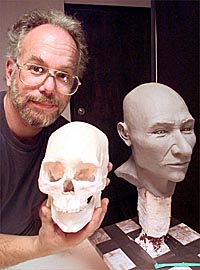Skip to comments.
Scientists Wait To Examine Kennewick Man (Update)
IOL ^
| 8-8-2004
| Tomas Alex Tizon
Posted on 08/10/2004 10:56:41 AM PDT by blam
Scientists wait to examine Kennewick Man
August 08 2004 at 04:58PM
By Tomas Alex Tizon
For a few days last week, the top forensic anthropologists in the United States thought they were finally going to get their chance to study Kennewick Man.
The eight-year legal battle over the 9 300-year-old bones, one of the oldest skeletons found in North America, appeared finished after five northwest Indian tribes decided not to pursue their case to the US supreme court. The tribes claimed that Kennewick Man was an ancestor and should not be desecrated by scientific study.
Two courts ruled in favour of the eight plaintiff scientists who believe the bones, discovered in 1996 along the Columbia River near Kennewick, Washington, could yield insights on the earliest inhabitants of the Americas. The skeleton, in one preliminary study, was found to have some Caucasian features, suggesting that groups other than Asians may have migrated to the continents thousands of years ago.
But soon after the scientists' apparent victory, a new legal obstacle emerged late last week, this time from the federal government. The US army's engineers corps, which has custody of the skeleton and which sided early on with the tribes, has objected to so many aspects of the scientists' study plan that a new round of litigation is probable, according to Alan Schneider, the scientists' attorney.
The earlier court battles focused on whether Kennewick Man should be subjected to scientific study. The new legal battle will be about how his bones will be studied.
Schneider predicts that he will have to go to court to compel the government to hand over the skeleton. "That seems to be the direction we're heading."
Jennifer Richman, an attorney for the engineers' corps, would say only that the scientists' plan was "subject to reasonable terms and conditions".
"We are trying to work it out," she said.
The tribes also wanted to have a say in how the bones were studied, hoping to minimise the "destruction of tissue" and the "desecration of the remains", said Debra Croswell, a spokesperson for the Umatilla Tribe in northeastern Oregon.
The tribes relied on the Native American Graves Protection and Repatriation Act of 1990, intended to protect tribal burials, to claim Kennewick Man so that, in Croswell's words, "the remains could be honoured and put back in the ground where they belong".
But a district court in Portland and later a federal appellate court said the tribes failed to prove an ancestral link to the skeleton.
Kennewick Man, made up of more than 350 bones, is being kept at the Burke Museum of Natural History and Culture in Seattle.
Scientists believe the bones belonged to a man who stood about 1,75m, suffered a severe spear wound to his hip, and was 40 to 50 years old when he died.
The man, according to one reconstruction, had more angular facial features than those typically associated with American Indians. The skull resembled those of Polynesians or the Ainu, the original inhabitants of Japan, whose features were more Caucasoid, scientists say.
The discovery caused a stir not just among tribes, whose identity as the continents' "original" inhabitants seemed jeopardised, but also among scientists whose long-standing theory on how the Americas were populated was turned on its head.
As recently as the mid-1990s, the prevailing theory was that North and South America were first populated by people from the Asian interior who crossed the Bering land bridge about 11 000 years ago.
Kennewick Man and the recent discoveries of ancient skeletons in South America seem to suggest that the continents were peopled by several waves of early migrants who used different routes.
George Gill, a forensic anthropologist at the University of Wyoming and one of the plaintiffs in the Kennewick Man case, said evidence indicated that seafaring people from southeast Asia or Polynesia could have reached the Americas by travelling along the Pacific Rim, landing somewhere in what is now South America. He said an ancient European people could also have reached the northeast corner of North America.
TOPICS: News/Current Events
KEYWORDS: archaeology; clovis; examine; ggg; godsgravesglyphs; history; kennewick; kennewickman; man; preclovis; precolumbian; scientists; wait
Navigation: use the links below to view more comments.
first previous 1-20, 21-22 last
To: usurper

AP PHOTO/KRISTA NILES
Actor Patrick Stewart poses for a photo in this May 20, 2002 file photo, at a hotel in Santa Monica, Calif. Stewart is recovering at home after undergoing an angioplasty procedure earlier this week to widen an artery, his publicist told The Associated Press Friday, Aug. 27, 2004.
To: SunkenCiv

Kennewick Man

Navigation: use the links below to view more comments.
first previous 1-20, 21-22 last
Disclaimer:
Opinions posted on Free Republic are those of the individual
posters and do not necessarily represent the opinion of Free Republic or its
management. All materials posted herein are protected by copyright law and the
exemption for fair use of copyrighted works.
FreeRepublic.com is powered by software copyright 2000-2008 John Robinson


